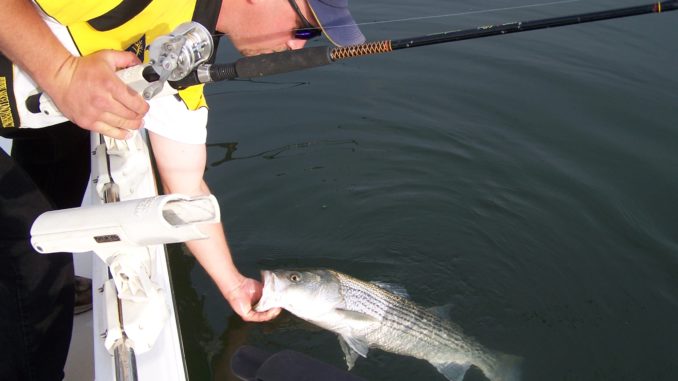
November kicks striped bass fishing into high gear across the Carolinas. Here’s where the action is.
Fall is a lot of things to a lot of different outdoorsmen, but for landlocked linesider fans, November’s cooling waters mean that hungry striped bass, aka rockfish, and their test-tube cousins, hybrid bass, will be moving into shallower water in search of prey.
Cold or cooler water and striped bass go hand in hand, as fish thrive better in lower water temperatures. Rather than simply surviving — which is what a lot of landlocked stripers do through the summer — water temperatures that dip below the 70-degree mark put striped bass in a much better mood and open up a lot more water in which they can comfortably roam. Coincidentally, threadfin shad start in November to bunch up and move en masse into creeks and over long points and shallow flats, so it’s not hard to guess where the best places to target striped bass will be.
Wildlife agencies in both North Carolina and South Carolina have embraced the striped bass and continue to support thriving put-grow-and-take fisheries across. Since minimal natural reproduction occurs in either state — and only in isolated areas — striped bass and hybrid striped bass are produced in state-supported hatcheries and released into local impoundments. If you are looking to get in on some hot striped bass action this fall, here’s a few lakes you should consider visiting: Lake Murray and Lake Hartwell in South Carolina and Lake Norman and Lake Tillery in North Carolina.
Historically, Lake Murray has struggled to produce both sizes and numbers of striped bass. Thanks in large part to some stringent regulations that were enacted several years ago, Murray has hit its stride, and fishermen are seeing a large population of big fish return to the lake.
Mike Gault of Jonesville, S.C., a retired wildlife enforcement officer, fishes Murray several times a week through the fall and winter. He has started a social media page on Facebook (www.facebook.com/Lake-Murray-Fishing-Reports) that provides up-to-date information on multiple species but focuses on the lake’s striper action.
“I believe we’re going to see an early fall, based on the water conditions we’ve seen over the summer,” Gault said. “Stripers will be moving into the upper water column, and it won’t be hard to find fish in places like Buffalo, Rocky, Hawlee and Cloud creeks. As the fall wears on, you’ll also see fish move into the upper reaches of the Big and Little Saluda rivers.”
Gault said fishing live blueback herring or gizzard shad behind planer boards will produce the best results once the water temperatures drop below 80 degrees, so the action will be wide open in November, when water temperatures in the mid-60s are common. He said having good electronics on your boat will be a tremendous help in eliminating unproductive water, as keying on baitfish movements will show you where the stripers are.
“You can also watch for birds diving on the water,” he said. “They start showing up on Murray in October and will stay here all winter. If you see birds working the surface, it’s almost a sure bet that stripers are working underneath, pushing baitfish to the top.”
Another go-to tactic on Murray is to cast a bucktail/ice fly rig to schooling fish. Gault suggests using a three-way swivel with a 14- to 18-inch dropper of 12-pound fluorocarbon for a white, ½-ounce bucktail and a 10- to 12-inch dropper of the same material for a chrome ice fly, which resembles a casting spoon and is available at most local tackle shops.
“You can cast the rig a mile, just let it sink a bit and then slow-roll it back to the boat,” Gault said. “On a good day, they’ll hit two at a time: one on the bucktail and another on the fly.”
On Lake Hartwell, guide Chip Hamilton expects to find striped bass and hybrids on two different patterns. The first is fishing live herring on downrods, a Carolina rig with a 1½-ounce egg weight, a 15- to 18-inch leader and a 1/0 Kahle hook just off the bottom on a hump near deep water.
“I target humps in 35 to 45 feet of water in November,” said Hamilton (864-304-9011). “That will usually produce a limit of fish from 2 pounds into the low teens in about four hours, once you get dialed in.”
His other pattern falls in line with Gault’s on Murray; he targets the backs of creeks with freelines and planer boards from 20 out to 50 feet of water.
“I’m targeting places like 18 Mile Creek, Coneross and Six and Twenty Creek,” said Hamilton. “I’ll go until I get to 20 feet in the middle of the creek and pull out. The creek may dip down to 50 or 60 feet, but I’m going to stay to one side or the other and pull a blueback herring about 20 feet behind the board and about 20 to 25 feet away from the boat.”
Hamilton said the planer-board bite seems to work better later in the morning, from 9 o’clock until noon. He suggests that the bigger females in the 15- to 20-pound range move into the backs of the creeks to chase threadfin shad and can’t resist a bigger blueback herring or even hand-sized gizzard shad that comes wandering by.
“I move slow, maybe a mile an hour,” he said. “You won’t catch as many fish in the creeks as you will out on the humps, but they will be much better size.”
In North Carolina, veteran angler Mike Lundy of Stony Point, N.C., suggests anglers visit Lake Norman once the air starts to cool. He also has a two-phase plan depending on whether the order of the day is a lot of bites from smaller fish or just a couple of bites from trophy-sized striped bass.
“The hybrid bite on Lake Norman has come on strong,” Lundy said. “You’ll find large numbers of hybrids this time of year in areas like Stumpy Creek, Goldmine Island, and around the (Duke Power) State Park. For big fish, especially if they’re running water, I’m going to head up the river.”
Lundy explained that at Lookout Shoals Lake, the impoundment upstream from Lake Norman, water is frequently run through the generators to make power. He said the cooler water and the current pull the bigger fish out of Norman and into the Catawba River upstream close to the I-40 bridge. He heads in that direction and pulls planer boards.
“I set the trolling motor just a touch faster than what the water is moving so I can control the boat,” Lundy said. “Then, I just go with the flow. I only put the baits about 6 feet behind the boards with no weight — or they will hang up in all the rocks.”
Lundy said both larger-sized blueback herring and gizzard shad work in the river. He advises anglers to watch out for large rocks. His primary focus will be from around I-40 down to Lyle Creek.
Planer boards will also work back down in the lake for catching Norman’s tremendous population of hybrids. Lundy will pull across points and the edges of creek channels around the state park area. Using planer boards and free lines works best early in the day on sunny days but may be the only tactic he uses if the weather is overcast.
Lundy also said expect to wade through a lot of spotted bass when pulling blueback herring. Sometimes, he can reduce the number of black bass by switching to downrods and fishing deeper out on the points, especially later in the day, but there’s no guarantee.
“You’ll also catch stripers but the hybrids and the spotted bass are so aggressive, they usually out-compete the stripers,” he said.
Rodney Crisco of Albemarle, N.C., a top tournament angler, sees a lot of striper fishermen come through his business, Joe’s Bait & Tackle, on a daily basis. In previous years, most were headed to Badin Lake, but this year, the more-popular destination has been Lake Tillery, two reservoirs downstream where the Yadkin and Uhwarrie rivers meet to form the Pee Dee River.Crisco said the reason why had to do with this year’s weather.
“Tillery is at the end of the Yadkin/Pee Dee chain, and we’ve had a lot of raw water come through the system, enough that the authorities have had to release water,” said Crisco. “I have guys come in here saying they’re catching hybrids in Tillery that were stocked way up the line. Tillery is where everything got collected.”
Crisco (704-982-8716) said another great thing about Tillery is there are plenty of blueback herring to feed its newly re-located residents.
“I’ve never seen the quality of topwater action before like we’ve had on Tillery all summer,” he said. “I’ve had to get on some of my customers about releasing some of those fish because people were catching limits every single day.”
Crisco said the typical fall pattern would be pulling free-lines and planer boards using blueback herring or 8- to 9-inch gizzard shad. He makes and sells his own line of Pro-Motion planer boards that handle both smaller herring and bigger gizzard shad without pulling off track.
“Tillery is 14 miles long and fishes almost like a river. Current is still important even 7 or 8 miles down the lake from the dam, (upstream),” he said. “The target water depth will be 10 to 15 feet, and we have plenty of that to troll.”
Crisco said his typical setup is to run a couple of freelines out the back of the boat and two or three planer boards on each side. On some occasions, he will also run two downrods baited with herring from the front of the boat using a 3-ounce sinker to keep the line vertical in the water. His trolling speed settles between 1 and 1.5 mph.
“After that,” he said. “It’s a matter of covering water and finding where the fish are holding that day.”

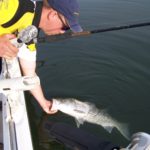
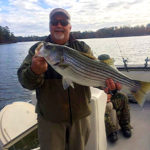
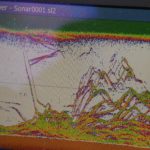
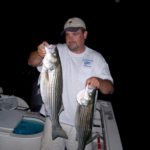

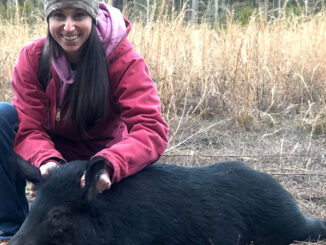
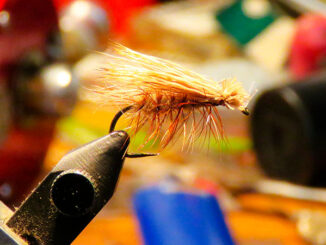

Be the first to comment